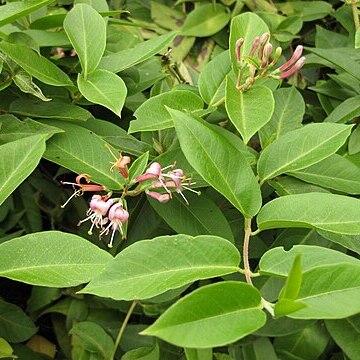Climbers, semievergreen. Branches usually becoming hollow. Branches, petioles, and peduncles with dense curved or spreading brown-yellow stiff hairs, sometimes interspersed with long glandular hairs, sometimes glabrescent or becoming glabrous. Leaves occasionally 3-whorled; petiole 2-15 mm; leaf blade ovate or oblong to linear-lanceolate, 2.5-13 × 1.3-4.5 cm, both surfaces brown-yellow hirsute at least on midvein or glabrescent, base rounded to cordate, margin often ciliate, apex acuminate to caudate. Flowers paired, axillary at apices of branchlets, sometimes paniculate; peduncle 0-23 mm, shorter toward apex of branchlets; bracts subulate, occasionally leaflike, 2-4 mm, pubescent and ciliate; bracteoles ovate, ca. 1 mm, glabrous to densely ciliate. Neighboring ovaries free, ca. 2 mm, glabrous, occasionally sparsely hairy, sometimes pruinose. Calyx lobes ovate to narrowly triangular, to 1.5 mm, margin ciliate, sometimes glabrous or glandular. Corolla bilabiate, white tinged red, becoming yellow tinged orange or purple, 1.5-2.4 cm, outside glabrous to densely pubescent; tube funnelform, 9-12 mm, diam. at throat 2-5 mm, inside hirsute, broadly and shallowly gibbous toward base; upper lip irregularly 4-lobed and erect, lobes orbicular-ovate, 1-2 mm; lower lip recurved. Stamens longer or subequaling corolla; filaments hirsute at base. Style exserted, hirsute at least in lower half or glabrous. Berries blue-black and pruinose, ovoid, 6-7 mm in diam.; seeds ellipsoid to oblong, slightly compressed, 4-4.5 mm, shallowly pitted. Fl. May-Jul, fr. Oct-Nov.
More
Woody climber or scrambling shrub. Twigs patently hirsute. Internodes rather short. Leaves ovate-oblong to lanceolate, variable in shape, base rounded, truncate or subcordate, apex acute to acuminate, texture often bullate by impressed nerves and reticulations, both sides green, hairiness in various degrees but midrib above always hairy, 3-8 by 1½-4 cm; petiole patent-yellow hairy, ¼-1 cm. Cymes mostly contracted towards the twig-ends, infl. not exceeding the leaves. Peduncle densely patent-hirsute, sometimes with few sessile glands. Bracts 5-8 mm rarely shorter, narrow triangular, as long as or longer than the ovary. Bracteoles 2 mm, acute oblong, shorter than the ovary. Calyx green, lobes ciliate, with a few stiff hairs on the back. Corolla 2-2½ cm long, sulphureous, not fragrant, rather thick and club-shaped in bud, in anthesis upper lip erect, lower lip reflexed; tube glabrous or with few reflexed strigose hairs, sometimes with few sessile glands. Style ± as long as the corolla, mostly hairy. Stamens mostly hairy. Berry black.
A climber. The branches usually become hollow. They have stiff, yellow-brown hairs. The leaves can be in rings of 3. The leaves are 3-13 cm long by 2-5 cm wide. The flowers occur in pairs in the axils of leaves near the ends of the branches. They are white tinged with red and can have yellow or orange.
Can be grown by cuttings or seedlings. Seeds needs stratification.

